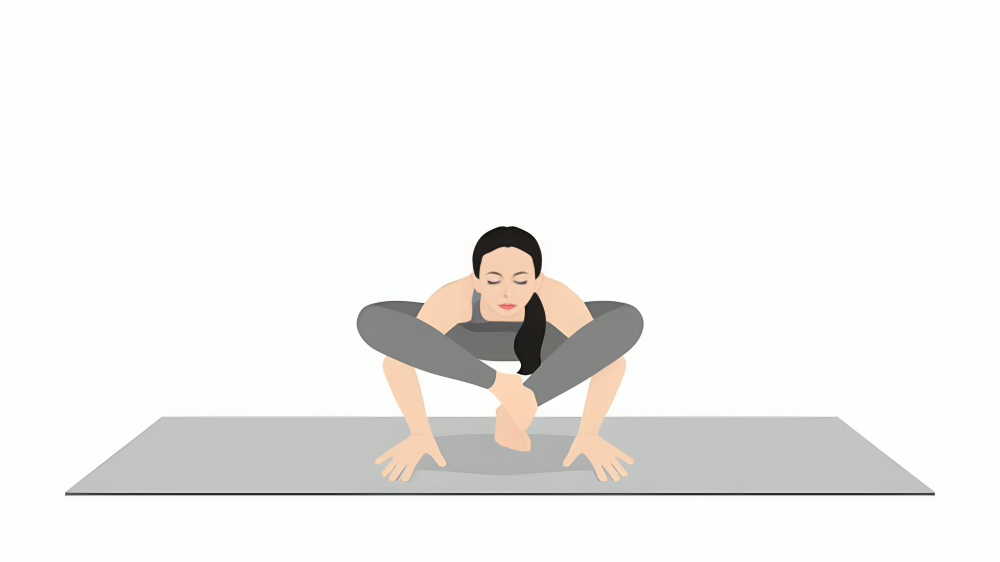
What is Bhujapidasana?
Bhujapidasana, commonly known as the Shoulder Pressing Pose, is an arm-balancing yoga asana that engages the upper body, core, and lower body in one powerful move. The Sanskrit name “Bhujapidasana” breaks down into three parts: “Bhuja” meaning arm or shoulder, “Pida” meaning pressure or force, and “Asana” meaning pose. So, in simple terms, it’s a pose where you press your arms to create a balance, leveraging your shoulders and upper arms to support the body.
This advanced yoga pose requires strength, flexibility, and focus, making it a favorite among seasoned yoga practitioners looking to challenge their bodies and minds. It’s part of the broader family of arm-balance poses, similar to Crow Pose (Bakasana), but with a unique twist that targets the hips, core, and shoulders.
How to Perform Bhujapidasana
Warm-Up
Before attempting Bhujapidasana, it’s essential to warm up your wrists, shoulders, and hips. Some great preparatory poses include Malasana (Garland Pose), Downward Dog, and Plank Pose. These will get your body ready for the deep hip flexion and arm strength required.
Starting Position
Begin by standing at the front of your mat. Move into a squatting position, bringing your feet about hip-width apart. Slowly, tilt your torso forward so that your arms can reach down between your legs. Your hands should come to the mat, palms flat, directly underneath your shoulders.
Engage Your Core and Arms
Once your hands are placed firmly on the mat, bend your elbows slightly and start working your knees toward your upper arms. Your knees should press against your triceps, near the top of your arms, as close to your armpits as possible. This positioning is key because your arms will help support and balance your body.
Lift Your Feet
Here comes the tricky part! Shift your weight onto your hands. Once you feel balanced, start lifting one foot at a time off the ground, crossing your ankles over one another. Keep engaging your core and shoulders to maintain stability.
Hold and Breathe
Once you’ve lifted both feet, hold the pose and focus on your breath. Try to stay here for 5–10 deep breaths. Keep your gaze forward to help with balance, and remember that your core is your foundation here—keep it engaged!
Exit Gracefully
To come out of the pose, slowly lower one foot at a time back onto the mat, returning to a squatting position. Rest in Child’s Pose or another seated position to recover and reflect on your practice.
Benefits of Bhujapidasana
Strengthens Upper Body and Core:
Bhujapidasana is a fantastic way to build upper body strength. Your arms, shoulders, and core are all working hard to hold you in place. Over time, this can improve your overall body strength, especially in the chest and arms.
Improves Balance and Coordination:
This pose is a test of balance and control. It requires focus and body awareness, which improves your coordination and mental clarity.
Stretches the Hips and Hamstrings:
Although it’s an arm-balance pose, Bhujapidasana also gives a nice stretch to your hips and hamstrings. It increases flexibility in the lower body, making it a great pose for those who sit for long periods.
Enhances Concentration:
Staying in this pose demands mental focus. You can’t balance without being fully present. Over time, practicing this asana can boost your concentration and mindfulness both on and off the mat.
Builds Confidence:
Successfully holding Bhujapidasana is empowering. As you progress in this pose, you’ll likely notice a boost in self-confidence as you accomplish something that initially seemed difficult.
Promotes Mind-Body Connection:
Like many yoga poses, Bhujapidasana teaches you to connect with your body’s movement and your breath. This union of mind and body helps foster a deeper sense of mindfulness.
It’s Here Urdhva Mukha Svanasana How to Do It and what are The Benefits
FAQs
1. Is Bhujapidasana suitable for beginners?
Bhujapidasana is considered an advanced yoga pose, but beginners can still work on building up to it with modifications and regular practice.
2. How long should I hold Bhujapidasana?
Start by holding the pose for 5–10 breaths. As you get more comfortable, you can increase the duration.
3. What should I do if I lose balance?
Falling out of arm-balancing poses is completely normal! Simply come back into a squat or Child’s Pose, take a breath, and try again.
4. Are there any risks to practicing Bhujapidasana?
If you have wrist, shoulder, or back injuries, this pose may put extra strain on those areas. It’s always a good idea to consult with a yoga instructor before trying advanced poses.

